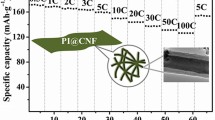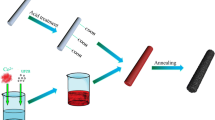Abstract
Developing advanced organic cathodes with significant charge–discharge performances would prove a potential alternative for traditionally inorganic cathode materials of lithium-ion batteries in the future. Herein, a conductive polymer as electrode with improved electrochemical performances was reported. Polyaniline (PANI) with fibrous morphology was firstly polymerized by using perchloric acid (HClO4) as the large molecular doped acid. Furthermore, the cross-linking PANI was prepared with using triphenylamine as the cross-linkers and p-phenylenediamine as the molecular chain extender. Applied as the cathode of lithium-ion batteries, the cross-linking PANI fibers with moderate cross-linking degree exhibited an improved electrochemical and cell performances, in which it presented a highest discharge specific capacity of 138.5 mAh·g−1 and a relatively stable capacity retention of around 126.3 mAh·g−1 after 150 cycles. Also, the cross-linking PANI exhibited the improved rate capabilities, and it could still provide a discharge specific capacity of 92.5 mAh·g−1 even at a higher current density of 500 mA.g−1, which is obviously higher than that of pure PANI. The work presented herein demonstrated that the cross-linking for conductive polymers was a potential way to obtain the improved electrochemical performances for the polymer-based electrode material.











Similar content being viewed by others
References
Li YG, Gong M, Liang YY, Feng J, Dai HJ (2013) Advanced zinc-air batteries based on high-performance hybrid electrocatalysts. Nat Commun 4:1805
Li WY, Cha JJ, Zheng GY, Yang Y, McDowell MT, Cui Y (2013) Sulphur-TiO2 yolk-shell nanoarchitecture with internal void space for long-cycle lithium-sulphur batteries. Nat Commun 4:1331
Zhang QF, Uchaker E, Candelaria SL, Cao GZ (2013) Nanomaterials for energy conversion and storage. Chem Soc Rev 42:3127–3171
Roberts ME, Wheeler DR, McKenzie BB, Bruce CB (2009) High specific capacitance conducting polymer supercapacitor electrodes based on poly(tris(thiophenylphenyl)amine). J Mater Chem 19:6977–6979
Ruzicka JY, Bakar FA, Thomsen L, Cowie BC, McNicoll C, Kemmitt T, Brand HEA, Ingham B, Andersson GG, Golovko VB (2014) XPS and NEXAFS study of fluorine modified TiO2 nano-ovoids reveals dependence of Ti3+ surface population on the modifying agent. RSC Adv 4:20649–20658
Liu XH, Lai WH, Chou SL (2020) The application of hollow micro-/nanostructured cathodes for sodium-ion batteries. Mater Chem Front 4:1289–1303
Chen D, Tan HT, Rui XH, Zhang Q, Feng YZ, Geng HB, Li CC, Huang SM, Yu Y (2019) Oxyvanite V3O5: a new intercalation-type anode for lithium-ion battery. InfoMat 1:251–259
Winter M, Barnett B, Xu K (2018) Before Li ion batteries. Chem Rev 118:11433–11456
Thackeray MM, Wolverton C, Isaacs ED (2012) Electrical energy storage for transportation-approaching the limits of, and going beyond, lithium-ion batteries. Energy Environ Sci 5:7854–7863
Xie J, Gu PY, Zhang QC (2017) Nanostructured conjugated polymers: nanostructured conjugated polymers: toward high performance organic electrodes for rechargeable batteries. ACS Energy Lett 2:1985–1996
Yuan LX, Wang Z, Zhang W, Hu X, Chen J, Huang Y, Goodenough JB (2011) Development and challenges of LiFePO4 cathode material for lithium-ion batteries. Energy Environ Sci 4:269–284
Wang HG, Zhang XB (2018) Organic carbonyl compounds for sodium-ion batteries: recent progress and future perspectives. Chem Eur J 24:18235–18245
Xie J, Wang ZL, Xu ZJ, Zhang QC (2018) Toward a high-performance all-plastic full battery with a single organic polymer as both cathode and anode. Adv Energy Mater 21:1–6
Lee J, Moon J, Han SA, Kim J, Malgras V, Heo YU, Kim H, Lee SM, Liu HK, Dou SX, Yamauchi Y, Park MS, Kim JH (2019) Everlasting living and breathing gyroid 3D network in Si@SiOx/C nanoarchitecture for lithium ion battery. ACS Nano 13:9607–9619
Liu J, Xia H, Xue D, Lu L (2009) Double-shelled nanocapsules of V2O5-based composites as high-performance anode and cathode materials for Li ion batteries. J Am Chem Soc 131:12086–12087
Gordana IM (2013) Recent advances in polyaniline composites with metals, metalloids and nonmetals. Synth Met 170:31–56
Song LF, Jiang CH, Jiao CL, Zhang J, Sun LX, Xu F, You WS, Wang ZG, Zhao JJ (2010) Two new metal-organic frameworks with mixed ligands of carboxylate and bipyridine: synthesis, crystal structure, and sensing for methanol. Cryst Growth Des 10:5020–5023
Poizot P, Dolhem F (2011) Clean energy new deal for a sustainable world: From non-CO2 generating energy sources to greener electrochemical storage devices. Energy Environ Sci 4:2003–2019
Liang Y, Tao Z, Chen J (2012) Organic electrodes: organic electrode materials for rechargeable lithium batteries. Adv Energy Mater 2:742–769
Kovalenko I, Bucknall DG, Yushin C (2010) Detonation nanodiamond and onion-like-carbon-embedded polyaniline for supercapacitors. Adv Funct Mater 20:3979–3986
Malka D, Giladi S, Hanna O, Weitman M, Cohen R, Elias Y, Attias R, Frimer BT, D, Aurbach (2019) Catechol-modified carbon cloth as hybrid electrode for energy storage devices. J Electron Mater 166:A1147–A1153
Jiménez P, Levillain E, Alévêque O, Guyomard D, Lestriez B, Gaubicher J (2017) Lithium n-doped polyaniline as a high-performance electroactive material for rechargeable batteries. Angew Chem 129:1–5
Tao W, Zhang H, Jia T, Luo S, Hou Q, Wang Y, Shi G, Xu B (2018) Two phenanthrenequinone-based compound cathode materials for lithium ion batteries. J Electron Mater 165:A1574–A1577
Xie J, Zhang Q (2016) Recent progress in rechargeable lithium batteries with organic materials as promising electrodes. J Mater Chem A 19:7091–7106
Hansen KA, Nerkar J, Thomas K, Bottle SE, Mullane APO, Talbot PC, Blinco JP (2018) New spin on organic radical batteries-an isoindoline nitroxide-Based High-voltage cathode material. ASC Appl Mater Interfaces 9:7982–7988
Wang X, Zhang C, Xu Y, He Q, Mu P, Chen Y, Zeng J, Wang F, Jiang JX (2018) Conjugated microporous polytetra(2-thienyl)ethylene as high performance anode material for lithium- and sodium-ion batteries. Macromol Chem Phys 7:1700524
Su C, He HH, Xu LH, Zhao K, Zheng CC, Zhang C (2017) Mesoporous conjugated polymer based on high free radical density polytriphenylamine derivative: its preparation and electrochemical performance as cathode material for Li-ion batteries. J Mater Chem A 5:2701–2709
Li P, Zhang X, Guo J, Shi G, Sang X, Ni C, Xu Y (2018) Fabrication of polyaniline/octa-(aminopropylsilsesquioxane) with enhanced electrochemical capacitance and improved cycling stability via in situ polymerization. Polym Bull 8:3395–3406
Bouarissa A, Gueddim A, Bouarissa N, Djellali S (2018) Band structure and optical properties of polyaniline polymer material. Polym Bull 7:3023–3033
Pardo MA, Valle MD, Díaz FR (2015) Synthesis and characterization of aniline and thiophene and/or alkylthiophenes polymers. Polym Bull 9:2189–2199
Wu YW, Zeng RH, Nan JM, Shu D, Qiu YC, Chou SL (2017) Quinone electrode materials for rechargeable lithium/sodium ion batteries. Adv Energy Mater 7:1700278
Zhu LM, Ding GC, Xie LL, Cao XY, Liu JP, Lei XF, Ma JX (2019) Conjugated carbonyl compounds as high-performance cathode materials for rechargeable batteries. Chem Mater 31:8582–8612
Häupler B, Wild A, Schubert US (2015) Carbonyls: Powerful organic materials for secondary batteries. Adv Energy Mater 5:1402034
Wang X, Deng JX, Duan XJ, Liu D, Guo JS, P, Liu (2014) Crosslinked polyaniline nanorods with improved electrochemical performance as electrode material for supercapacitors. J Mater Chem A 31:12323–12329
MacDiarmid AG, Chiang JC, Richter AF, Epstein AJ (1987) Polyaniline: a new concept in conducting polymers. Synth Met 18:285–290
Ryu KS, Kim KM (2008) A hybrid power source with a shared electrode of polyaniline doped with LiPF6. J Power Sources 165:420–426
Ahmoud M, Maher FEK, Deepak D, Tran TT, Dusan L (2020) Self-assembly and cross-linking of conducting polymers into 3D hydrogel electrodes for supercapacitor applications. ASC Appl Energy Mater 1:923–932
Prigodin VN, Efetov KB (1993) Localization transition in a random network of metallic wires: a model for highly conducting polymers. Phys Rev Lett 19:2932–2935
Christoph W (2005) Synthesis, processing and properties of conjugated polymer networks. Chem Comm 43:5378–5389
Wang TS, Sun HJ, Peng TJ, Liu B, Hou Y, Lei B (2020) Preparation and characterization of polyaniline/p-phenylenediamine grafted graphene oxide composites for supercapacitors. J Mol Struct 1221:128835
Li Y, Bober P, Trchova M, Stejskal J (2017) Colloidal dispersions of conducting copolymers of aniline and p-phenylenediamine for films with enhanced conductometric sensitivity to temperature. J Mater Chem C 7:1668–1674
Massi M, Albonetti C, Facchini M, Cavallini M, Biscarini F (2006) Toward amorphous conductors: enhanced conductivity of doped polyaniline via interchain crosslinking promoted by acid-functionalized aluminum quinolines. Adv Mater 20:2739–2742
Chaudhari HK, Kelkar DS (1997) Investigation of structure and electrical conductivity in doped polyaniline. Polym Int 4:380–384
Niu HJ, Luo PH, Zhang ML, Zhang L, Hao LN, Luo J, Bai XD, Wang W (2009) Multifunctional, photochromic, acidichromic, electrochromic molecular switch: novel aromatic poly(azomehine)s containing triphenylamine Group. Eur Polym J 45:3058–3071
Liu P, Zhang P, Cao DL, Gan LH, Li YF (2013) New side groups-tuned triphenylamine-based chromophores: synthesis, morphology, photophysical properties and electronic structures. J Mol Struct 1050:151–158
Jiménez P, Levillain E, Alévêque O, Guyomard D, Lestriez B, Gaubicher J (2017) Lithium n-doped polyaniline as a high-performance electroactive material for rechargeable batteries. Angew Chem Int Ed 56:1–5
Ryu KS, Kim KM, Kang SG, Lee GJ, Joo J, Chang SH (2000) The charge/discharge mechanism of polyaniline films doped with LiBF4 as a polymer electrode in a Li secondary battery. Solid State Ionics 135:229–234
Ryu KS, Kim KM, Kang SG, Lee GJ, Joo J, Chang SH (2000) Electrochemical and physical characterization of lithium ionic salt doped polyaniline as a polymer electrode of lithium secondary battery. Synth Met 110:213–217
Lin T, Chen IW, Liu FX, Yang CY, Bi H, Xu FF, Huang FQ (2015) Nitrogen-doped mesoporous carbon of extraordinary capacitance for electrochemical energy storage. Science 6267:1508–1513
Rajagopal R, Ryu KS (2018) Facile hydrothermal synthesis of lanthanum oxide/hydroxide nanoparticles anchored reduced grapheme oxide for supercapacitor applications. J Ind Eng Chem 60:441–450
Xu YS, Wang SP, Peng HL, Yang ZG, Martin DJ, Bund A, Nanjundan AK, Yamauchi Y (2019) Electrochemical characteristics of the cobaltosic oxide in organic electrolyte according to bode plots: double-layer capacitance and pseudocapacitance. ChemElectroChem 6:2456–2463
Acknowledgements
This research was financially supported by the National Science Foundation of China (Grant No.51573099), the Natural Science Foundation of Liaoning Province, China (Grant No.2020-MS-232), Liaoning BaiQianWan Talents Program ([2020]78 (2020921096)) and Scientific research project of Liaoning Provincial Department of Education (LJ2020004 and LJ2020005).
Author information
Authors and Affiliations
Corresponding author
Additional information
Publisher's Note
Springer Nature remains neutral with regard to jurisdictional claims in published maps and institutional affiliations.
Rights and permissions
About this article
Cite this article
Xu, L., Xin, H. & Su, C. Effect of cross-linking on electrochemical performances of polyaniline as the cathode material of lithium-ion batteries. Polym. Bull. 79, 5261–5278 (2022). https://doi.org/10.1007/s00289-021-03747-1
Received:
Revised:
Accepted:
Published:
Issue Date:
DOI: https://doi.org/10.1007/s00289-021-03747-1




